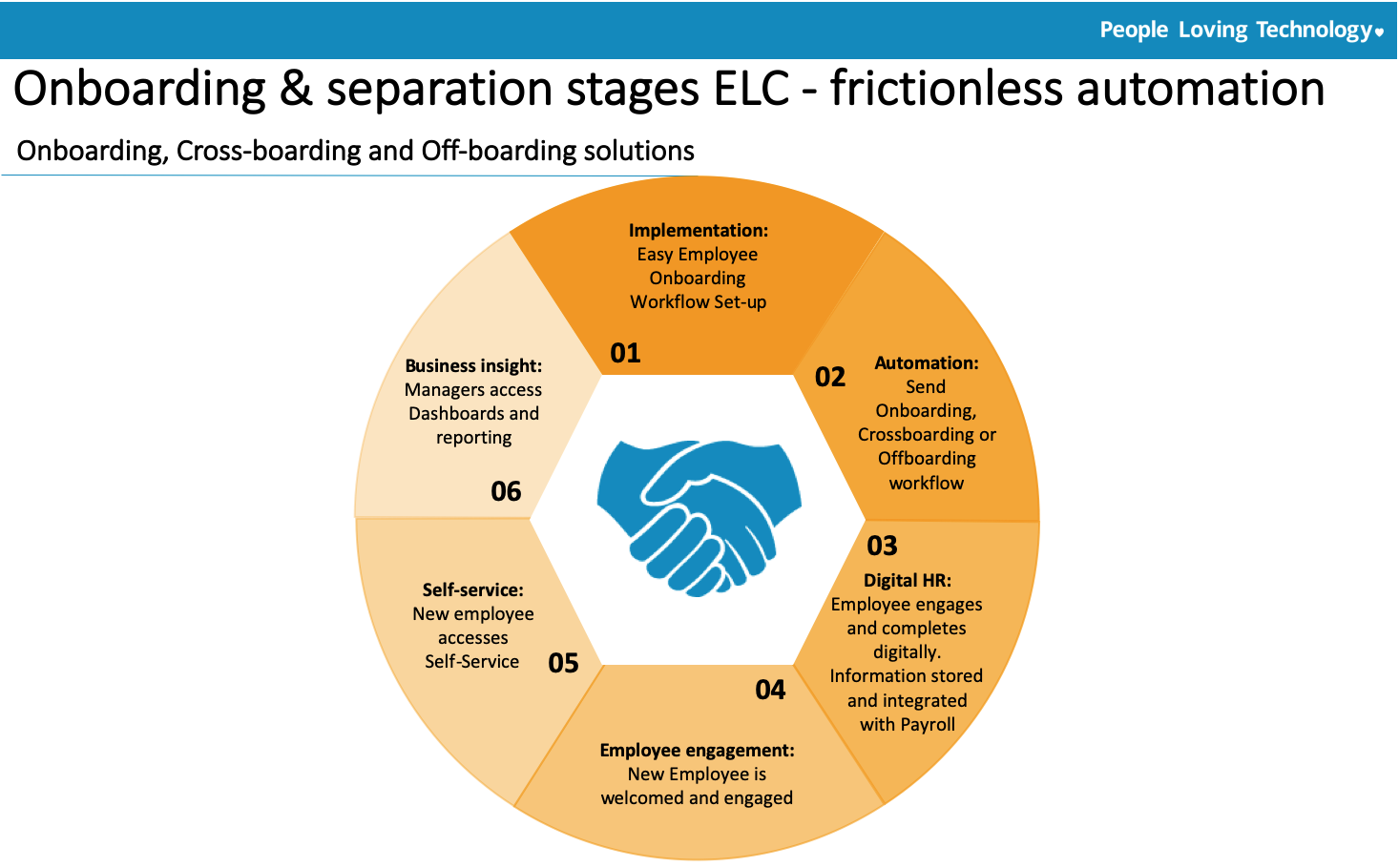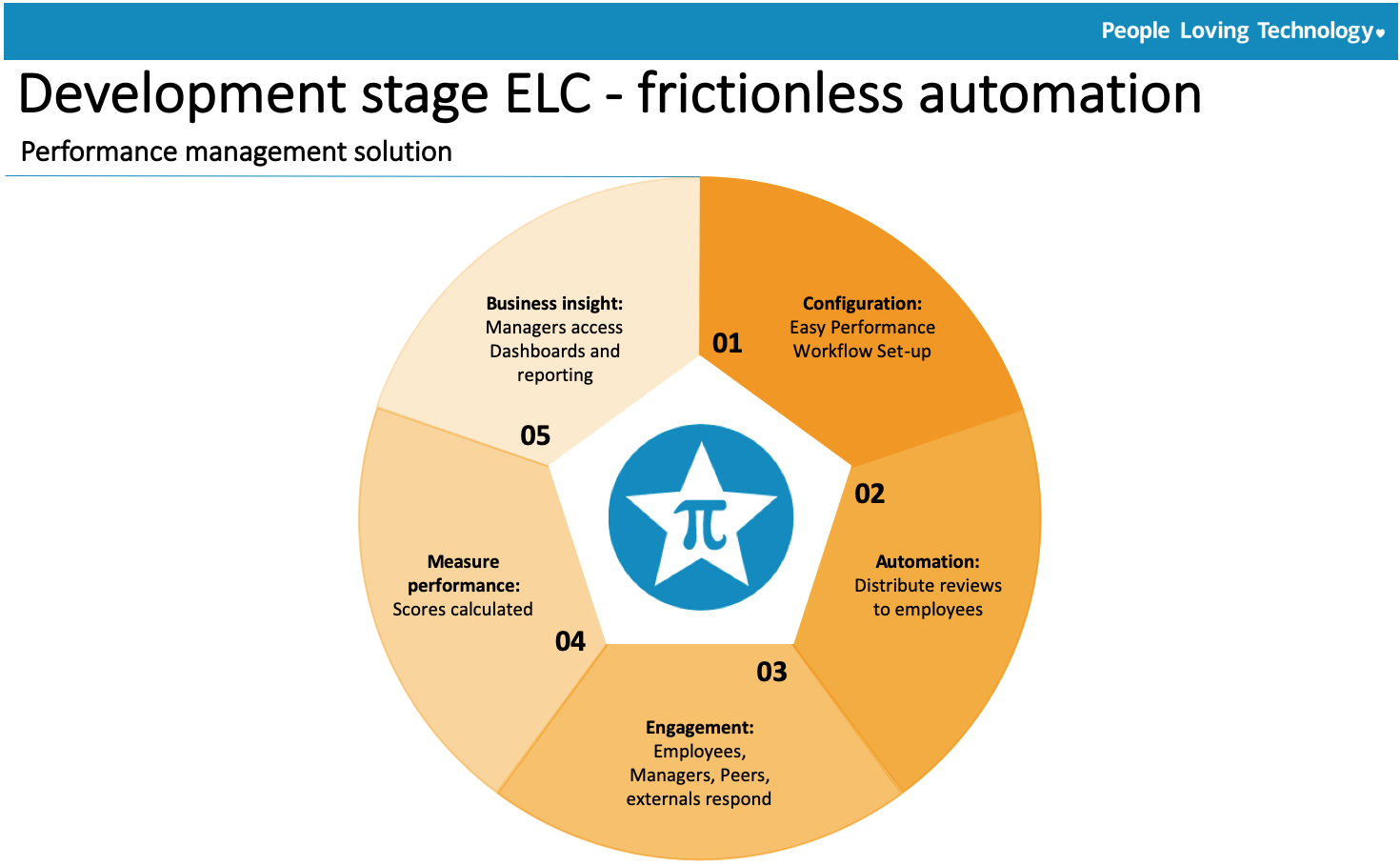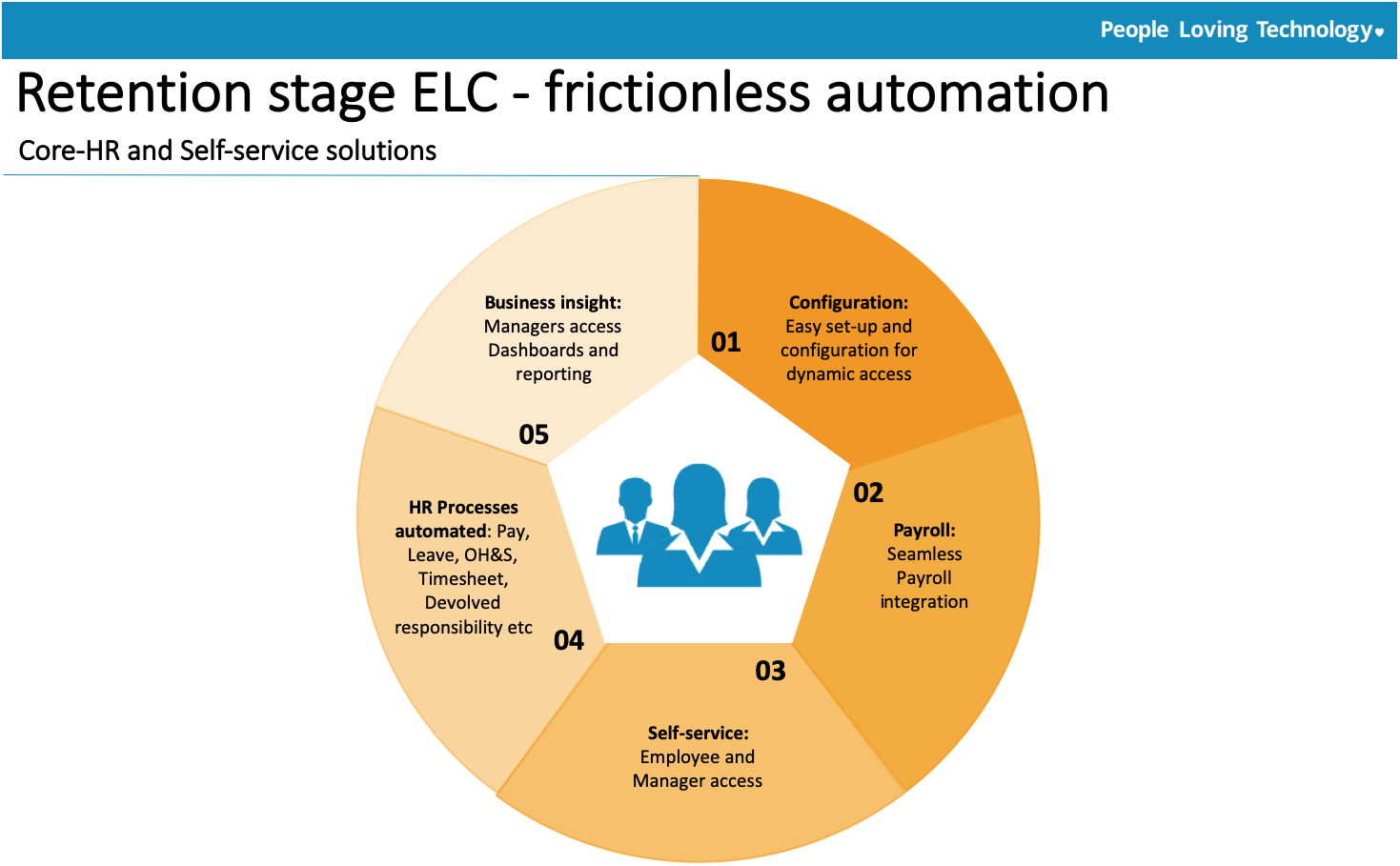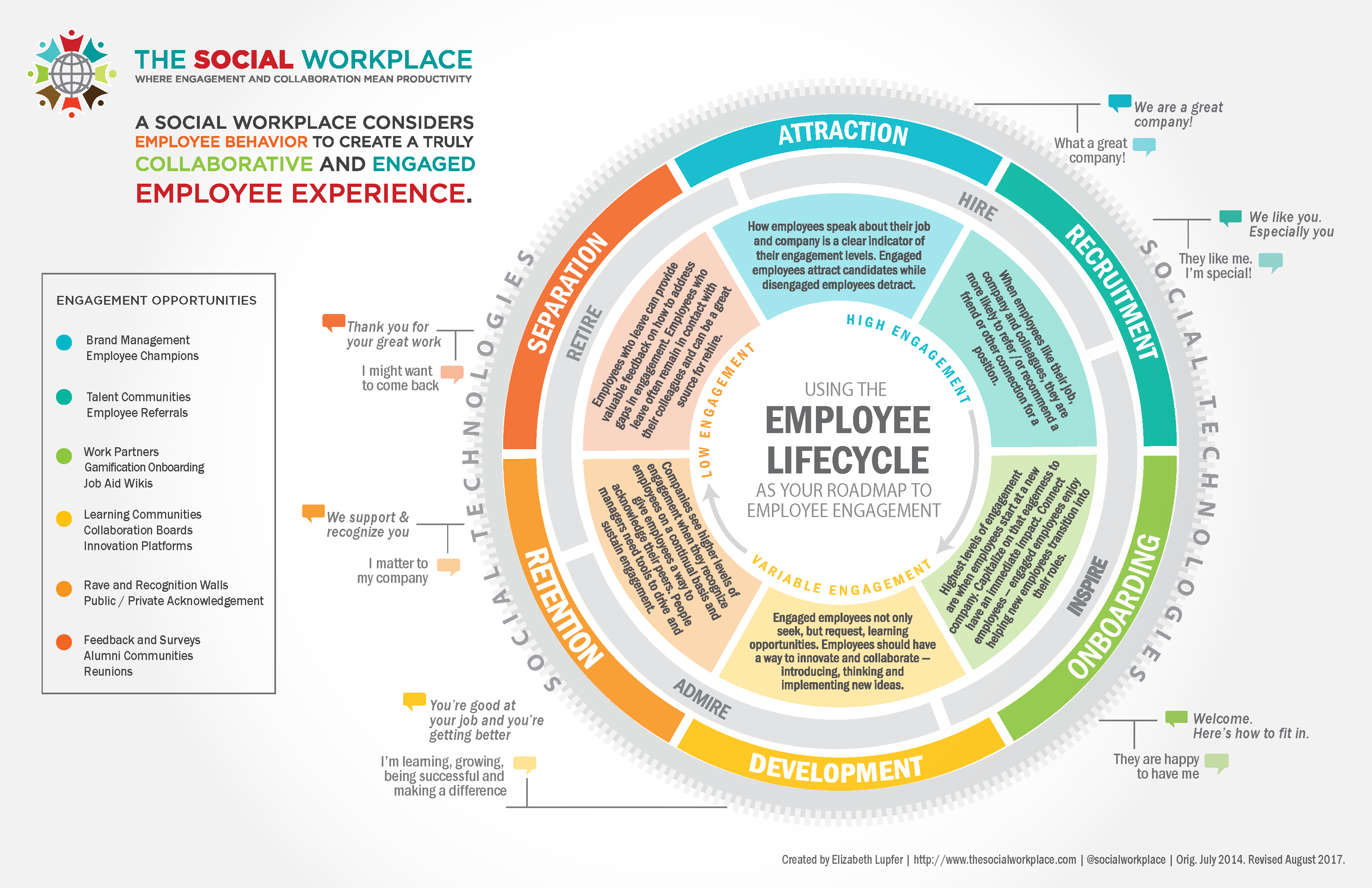The Employee Lifecycle (ELC) is your roadmap to building an engaged employee experience. Cloud HR software is how you digitally transform your employee lifecycle to reduce friction and deliver powerful results to potential, current (and maybe even past) employees that is simple, automated and engaging. In this week's HR Blog we explore how to make your employee lifecycle sing...
The Six Stages of the Employee Lifecycle
The Employee Lifecycle (ELC) model outlines six stages of engagement an organisation has with an employee. These six stages can be illustrated as an ongoing, perpetual lifecycle, as shown below in the diagram below.

By optimising each stage of your ELC, it is possible to attract and retain a top tier talent for your business. Here are the highlights for each stage of the lifecycle.
-
Attraction: Build the right brand and culture to attract the best candidates to your business.
-
Recruitment: Develop a multi-channel recruitment strategy and don't forget referrals when assessing who is the best fit for both your company and the role.
-
Onboarding: Provide an engaging employee experience is essential to the retention and the success of new team members, existing employees and the organisation.
-
Development: Foster ongoing professional development and continuous improvement across your business.
-
Retention: Develop strategies and processes to ensure you retain your top talent. A positive company culture is essential.
-
Separation: All good things must come to an end. Put a process in place to learn from the experience, continue good morale within your team, and ensure that departing employees leave on good terms...
Attraction Stage of the Employee Lifecycle

It doesn't matter how fancy your product or service is, or how many problems it solves, organisations who don’t attract and retain great people will always play second fiddle to those that do. This is why the attraction stage of the ELC is crucial to the ongoing success of your business.
Consider the following tips for success in the attraction stage:
-
Build a brand reputation that inspires potential employees to want to work with you.
-
Create a great culture that your employees evangelise to friends, family, colleagues.
-
Offer unbeatable compensation and benefits.
Want to discover the latest about compensation and benefits - take a look at our HR Metrics, Statistics and Trends White Paper that outlines everything you need to know about the latest compensation and benefits trends.
Need Cloud HR software to automate and optimise your attraction stage - take a look at our Jobs Board and e-Recruitment solutions.
Recruitment Stage of the Employee Lifecycle

With wage stagnation and top tier talent in high demand, recruitment is more competitive than ever. Ensuring that you have multi-channel strategy with an intelligent plan to secure great talent, creates a great candidate experience.
Consider the following tips for success in the recruitment stage:
-
Tap your existing employees for referrals about great talent.
-
Be active across multiple recruitment channels like; Facebook, LinkedIn, Jobs Boards, and other digital real estate where potential employees can find your vacancies.
-
Get specific about the right candidate, not only for the role, but for your unique organisational fingerprint and culture.
-
Involve your current employees in the process to amplify buy-in and ownership of the process (and your new team member/s).
Want to discover how to hire the right people for your business - take a look at our Values Based Recruitment White Paper that outlines everything you need to know about aligning the values of your business with the values of your employees.
Need Cloud HR software to automate and optimise your attraction stage - take a look at our Jobs Board and e-Recruitment solutions.
Onboarding Stage of the Employee Lifecycle

All the research illustrates that onboarding is a litmus test for getting new hires adjusted to 'how we do things around here' quickly and smoothly. It is the process through which new hires learn the attitudes, knowledge, skills, and behaviours required to function effectively within your organisation. The degree to which leadership makes new hires feel welcomed into the team and prepared for their new roles, the faster that they will be able to successfully contribute to the organisation’s mission.
Consider the following tips for success in the onboarding stage:
-
Have a detailed job description that accurately reflects responsibilities and expectations.
-
Live your company values and vision in word and action.
-
Create a schedule to connect regularly to discuss progress, issues and course-correct where necessary.
Want to discover how to ace onboarding in your business - take a look at our Automated Employee Onboarding White Paper that outlines everything you need to know about onboarding success. Better still, we offer our Onboarding solution FOR FREE! Request your personalised demonstration here.
Development Stage of the Employee Lifecycle

Learning and development comes close to the top of the list for Millennials. That means you need to consistently provide professional development and create opportunities for continuous improvement amongst your team. Put systems and processes in place that will provide your team with training that will enhance their future career path, even after they leave your business.
Consider the following tips for success in the development stage:
-
Assess employee skills and knowledge collaboratively.
-
Encourage internal and external learning experiences.
-
Enable your employees to be responsible for their own development.
-
Provide systems that facilitate just in time learning opportunities.
Want to discover important learning and development is to your business - take a look at our HR Blog called 'The Leaning Curve is the Earning Curve.'
Need Cloud HR software to automate and optimise your development stage - take a look at our Performance Management solution.
Retention Stage of the Employee Lifecycle

The critical success factor for retention is your company culture, because after all, culture eats strategy for breakfast. A negative company culture will result in high employee turnover, which will have the flow-on effect of impacting your bottom line, morale (and more). Replacing employees is an expensive overhead, so anything you can do to avoid it is a worthwhile investment.
Consider the following tips for success in the retention stage:
-
Hire people with the right skills and the right values to begin with.
-
Develop a collaborative, supportive and transparent team environment.
-
Ensure that every member of your organisation lives and breathes your culture, values and mission (in word and action).
-
Seek continuous feedback and measure morale regularly.
Want to discover how to retain top tier talent - take a look at our HR Blog called 'How Can Your Business Become a Great Place to Work.'
Need Cloud HR software to automate and optimise your retention stage - take a look at our Core-HR and Self-Service solutions.
Separation Stage of the Employee Lifecycle

It's true that all good things must come to an end, but that doesn't mean that the ending needs to cause any pain. Departures can impact other team members and it is the manager or HR professional's job to make sure the exit doesn’t disrupt business as usual.
Consider the following tips for success in the separation stage:
-
Ask for honest feedback.
-
Make sure you understand the reasons for the departure and course-correct where needed.
-
Do what needs to be done to ensure 'business as usual' the day after departure and beyond.
Want to discover how to make sure your people don't want to leave your business - take a look at our HR Blog called 'A Good Business is Built on a Human Workplace Culture.'
Need Cloud HR software to automate and optimise your separation stage - take a look at our FREE Onboarding solution - it manages cross-boarding and off-boarding too.
The Employee Lifecycle in a State of Perpetual Flow
The Social Workplace has created this brilliant diagram of the employee lifecycle, which illustrates the benefits of creating a process that leads to the success of your people AND your business. As outlined below, all employees interact with your organisation through a cyclical process: from the time they start thinking about you as a potential employer, to when they become an employee and all the way through to departure. The Social Workplace advocates a simplified approach that could also be called 'Hire-Inspire-Retire.' No matter how you define it, the employee lifecycle is the foundation for balancing business needs with the needs of your employees.

Do you have a system in place within your organisation that enables you to develop your employees, manage performance and automate the administrative burden of managing Employees? To find out more about how the Team Dashboards solution can improve your efficiency in managing the all six stages of the employee lifecycle, watch the self-paced discovery videos. There's a library of over 80 videos that illustrate the features and benefits of Subscribe-HRs Codeless Cloud HR Software.
Image Credit: The Social Workplace


